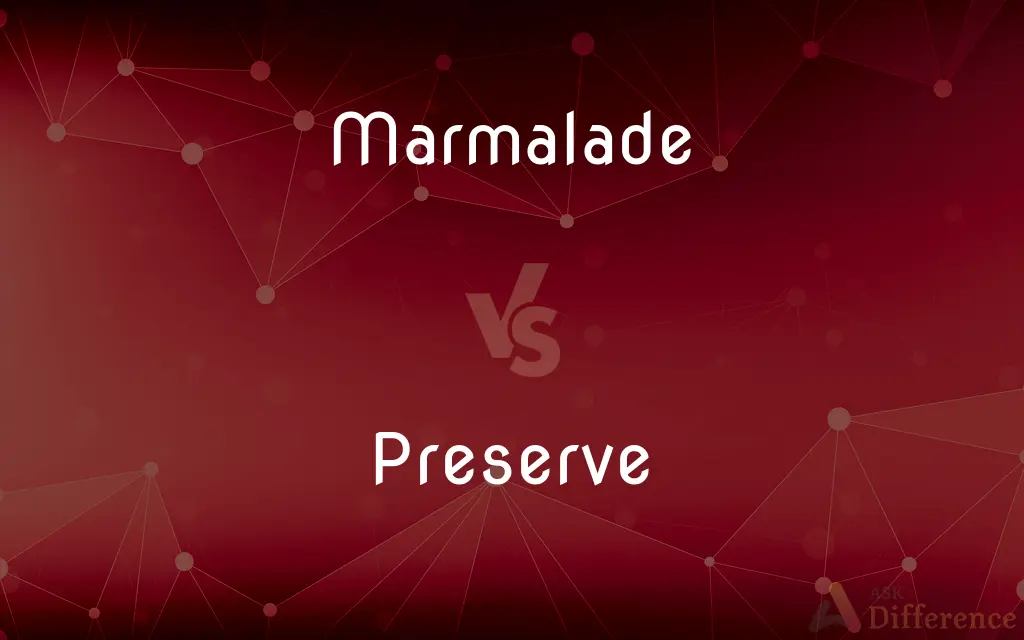Marmalade vs. Preserve — What's the Difference?
By Fiza Rafique & Maham Liaqat — Updated on April 5, 2024
Marmalade is a citrus-based spread made from the juice and peel of citrus fruits, boiled with sugar and water, while preserves are chunks of fruit in sugar syrup or jam with visible fruit pieces.

Difference Between Marmalade and Preserve
Table of Contents
ADVERTISEMENT
Key Differences
Marmalade is traditionally made from citrus fruits, such as oranges, lemons, limes, or grapefruits. The inclusion of the peel gives it a distinctive bitter taste and texture. On the other hand, preserves can be made from a variety of fruits, not limited to citrus, and are characterized by large pieces of fruit or whole fruits in a thick, sweet syrup or jam.
The preparation of marmalade involves cooking the fruit peel and pulp with sugar and water until it reaches a gel-like consistency. This process allows the natural pectin in the citrus peel to set the marmalade. In contrast, preserves are made by cooking fruit with sugar until the pieces are suspended in a thick syrup, sometimes necessitating added pectin to achieve the desired consistency.
Marmalade is often used as a spread on toast, bread, or scones and is known for its slightly bitter and tangy flavor. Preserves, with their chunks of fruit, offer a more textured experience and are used similarly but can also accompany cheeses, meats, and desserts, providing a sweet and slightly tangy flavor.
Another key difference is the texture. Marmalade has a soft, jelly-like consistency interspersed with pieces of citrus peel, offering a contrast in each bite. Preserves, however, are more about the feel of succulent fruit pieces enveloped in a soft, sweet gel.
While marmalade is almost exclusively made from citrus fruits, preserves have a much wider range of flavors, depending on the fruit used, such as strawberry, raspberry, apricot, or peach. This variety allows for a broader range of culinary uses and flavor profiles in preserves compared to the more narrowly defined taste of marmalade.
ADVERTISEMENT
Comparison Chart
Base Fruit
Citrus fruits only (oranges, lemons, etc.)
Any type of fruit
Texture
Jelly-like with chewy pieces of citrus peel
Chunky fruit pieces in syrup or jam
Flavor
Bitter and tangy
Sweet with the natural flavor of the fruit
Preparation
Includes the peel, cooked with sugar and water
Fruit cooked with sugar, may include added pectin
Culinary Uses
Spread on bread, toast, or scones
Spread on bread, accompaniment to cheeses/meats
Compare with Definitions
Marmalade
A fruit preserve made from the juice and peel of citrus fruits boiled with sugar and water.
Orange marmalade is a classic spread for morning toast.
Preserve
A type of jam made with large pieces or whole fruit in a thick syrup or jelly.
Strawberry preserves are delightful on fresh scones.
Marmalade
Characterized by its bitter and tangy taste due to the inclusion of citrus peel.
She loved the tangy bite of lemon marmalade.
Preserve
Characterized by chunks of fruit suspended in syrup.
The preserve was filled with large, succulent pieces of peach.
Marmalade
Traditionally consumed at breakfast.
Marmalade has been a breakfast staple in Britain for centuries.
Preserve
Made from a variety of fruits, not limited to citrus.
Apricot preserves offer a sweet, tangy addition to any dessert.
Marmalade
Requires the fruit to gel using its natural pectin.
Making marmalade is an art, balancing sugar, water, and the natural pectin from the citrus peel.
Preserve
Can be used as a spread or as an accompaniment to savory dishes.
She served cheese with fig preserves.
Marmalade
Often has a jelly-like consistency interspersed with pieces of peel.
The marmalade set perfectly, with a glossy finish and chunks of orange peel.
Preserve
Sometimes requires added pectin to achieve the desired consistency.
To make raspberry preserves, she added a bit of pectin to ensure it would set.
Marmalade
Marmalade is a fruit preserve made from the juice and peel of citrus fruits boiled with sugar and water. The well-known version is made from bitter orange, but it is also made from lemons, limes, grapefruits, mandarins, sweet oranges, bergamots, and other citrus fruits, or a combination.
Preserve
To keep from injury, peril, or harm; protect.
Marmalade
A clear, jellylike preserve made from the pulp and rind of fruits, especially citrus fruits.
Preserve
To keep in perfect or unaltered condition; maintain unchanged
Fossils preserved in sediments.
A film preserved in the archives.
Marmalade
A kind of jam made with citrus fruit, distinguished by being made slightly bitter by the addition of the peel and by partial caramelisation during manufacture. Most commonly made with Seville oranges, and usually qualified by the name of the fruit when made with other types of fruit.
Lime marmalade
Thick cut marmalade
Preserve
To keep or maintain intact
Tried to preserve family harmony.
Marmalade
Ellipsis of orange marmalade
Preserve
To prepare (food) for storage or future use, as by canning or salting.
Marmalade
(obsolete) quince jam
Preserve
To prevent (organic bodies) from decaying or spoiling
Preserved the specimen in a chemical solution.
Marmalade
(transitive) To spread marmalade on.
Preserve
To protect (wildlife or natural resources) in a designated area, often for regulated hunting or fishing.
Marmalade
A preserve or confection made of the pulp of fruit, as the quince, pear, apple, orange, etc., boiled with sugar, and brought to a jamlike consistency.
Preserve
To maintain (an area) for the protection of wildlife or natural resources.
Marmalade
A preserve made of the pulp and rind of citrus fruits
Preserve
To treat fruit or other foods so as to prevent decay.
Preserve
To maintain an area for the protection of wildlife or natural resources.
Preserve
Something that acts to preserve; a preservative.
Preserve
Often preserves Fruit cooked with sugar to protect against decay or fermentation.
Preserve
An area maintained for the protection of wildlife or natural resources.
Preserve
Something considered as being the exclusive province of certain persons
Ancient Greek is the preserve of scholars.
Preserve
A sweet spread made of any of a variety of fruits.
Preserve
A reservation, a nature preserve.
Preserve
An activity with restricted access.
Preserve
To protect; to keep from harm or injury.
Every people have the right to preserve its identity and culture.
Preserve
To save from decay by the use of some preservative substance, such as sugar or salt; to season and prepare (fruits, meat, etc.) for storage.
To preserve peaches or grapes
Preserve
To maintain throughout; to keep intact.
To preserve appearances; to preserve silence
Preserve
To keep or save from injury or destruction; to guard or defend from evil, harm, danger, etc.; to protect.
O Lord, thou preserved man and beast.
Now, good angels preserve the king.
Preserve
To save from decay by the use of some preservative substance, as sugar, salt, etc.; to season and prepare for remaining in a good state, as fruits, meat, etc.; as, to preserve peaches or grapes.
You can not preserve it from tainting.
Preserve
To maintain throughout; to keep intact; as, to preserve appearances; to preserve silence.
Preserve
To make preserves.
Preserve
To protect game for purposes of sport.
Preserve
That which is preserved; fruit, etc., seasoned and kept by suitable preparation; esp., fruit cooked with sugar; - commonly in the plural.
Preserve
A place in which game, fish, etc., are preserved for purposes of sport, or for food.
Preserve
A domain that seems to be specially reserved for someone;
Medicine is no longer a male preserve
Preserve
A reservation where animals are protected
Preserve
Fruit preserved by cooking with sugar
Preserve
Keep or maintain in unaltered condition; cause to remain or last;
Preserve the peace in the family
Continue the family tradition
Carry on the old traditions
Preserve
Keep in safety and protect from harm, decay, loss, or destruction;
We preserve these archeological findings
The old lady could not keep up the building
Children must be taught to conserve our national heritage
The museum curator conserved the ancient manuscripts
Preserve
To keep up and reserve for personal or special use;
She saved the old family photographs in a drawer
Preserve
Prevent (food) from rotting;
Preserved meats
Keep potatoes fresh
Preserve
Maintain in safety from injury, harm, or danger;
May God keep you
Preserve
Keep undisturbed for personal or private use for hunting, shooting, or fishing;
Preserve the forest and the lakes
Common Curiosities
What is marmalade?
Marmalade is a spread made from citrus fruits, sugar, and water, known for its bitter and tangy flavor from the inclusion of the peel.
Are preserves healthier than marmalade?
The healthiness depends on the sugar content and the fruit used; both can be part of a balanced diet in moderation.
What distinguishes preserves from jam or jelly?
Preserves are characterized by large chunks or whole pieces of fruit in a syrup or jelly, unlike jam, which is more pureed, and jelly, which is made from fruit juice.
Can marmalade be made from any fruit?
Traditionally, marmalade is made from citrus fruits only, though some modern recipes may experiment with other fruits.
Why is marmalade often associated with breakfast?
Its tangy flavor complements morning foods like toast and scones, making it a traditional breakfast spread.
Do marmalade and preserves need to be refrigerated?
Once opened, both should be refrigerated to preserve their freshness and prevent spoilage.
How long can marmalade and preserves last?
Properly canned and unopened, they can last for up to a year. Once opened, they should be consumed within a month for the best quality.
Why do some people prefer preserves over marmalade?
Personal preference for the sweetness and texture of preserves, with chunks of fruit, over the bitter tanginess of marmalade.
Can you make preserves without added pectin?
Yes, if the fruit naturally contains enough pectin or if you cook it down for longer to reach the desired thickness.
Can you cook with marmalade and preserves?
Yes, both can be used in cooking and baking for adding flavor to dishes, from glazes to fillings.
Can diabetics consume marmalade or preserves?
They contain high sugar levels, so diabetics should consume them cautiously and consider sugar-free or low-sugar options.
Is all marmalade orange-flavored?
No, while orange is the most traditional, marmalade can also be made from lemons, limes, grapefruits, and other citrus fruits.
Are there savory uses for marmalade and preserves?
Yes, both can be used in sauces, glazes, and accompaniments for meats, adding a sweet and tangy flavor.
Share Your Discovery

Previous Comparison
Allegory vs. Analogy
Next Comparison
Concise vs. UnconciseAuthor Spotlight
Written by
Fiza RafiqueFiza Rafique is a skilled content writer at AskDifference.com, where she meticulously refines and enhances written pieces. Drawing from her vast editorial expertise, Fiza ensures clarity, accuracy, and precision in every article. Passionate about language, she continually seeks to elevate the quality of content for readers worldwide.
Co-written by
Maham Liaqat















































